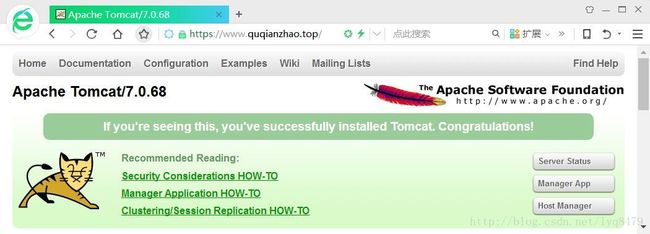全民https时代,Let's Encrypt免费SSL证书的申请及使用(Tomcat版)
近几年,在浏览器厂商的强力推动下,HTTPS的使用率大增。据统计,Firefox加载的网页中启用HTTPS的占比为67%,谷歌搜索结果中HTTPS站点占比已达50%,HTTPS网站已获得浏览器和搜索引擎的共同青睐。据悉,浏览器开发商Mozilla,Google准备采取下一步措施:将所有的HTTP网站标记为不安全。
近两年,微信小程序也异常火爆,小程序相关话题频频在朋友圈刷屏。如果你想开发微信小程序,一样绕不开HTTPS。根据微信小程序开发文档介绍,小程序与服务器交互必须使用HTTPS协议。
不管是大势所趋,还是实际项目开发需要,掌握如何给网站添加HTTPS协议支持(Web服务器设置使用SSL证书后,网站就能支持HTTPS访问了)都是非常有必要的。
一般来说,很多公司都会直接购买由GlobalSign、GeoTrust、Verisign等全球公认的数字证书颁发机构颁发的SSL证书。购买?没错,大多数SSL证书都需要按年付费使用,而且价格不菲。很多小公司、创业团队或个人开发者往往不愿意承担这笔费用,那有没有免费的SSL证书可以使用?
Let's Encrypt 是一个免费、开放,自动化的证书颁发机构,由 ISRG(Internet Security Research Group)运作。ISRG 是一个关注网络安全的公益组织,其赞助商包括 Mozilla、Akamai、Cisco、EFF、Chrome、IdenTrust、Facebook等公司。ISRG 的目的是消除资金和技术领域的障碍,全面推进网站从HTTP到HTTPS过度的进程。
目前,包括FireFox、Chrome在内的主流浏览器都支持Let's Encrypt证书,已经有不少用户在真实项目中使用Let's Encrypt证书。Let's Encrypt免费SSL证书的有效期是90天,到期后可以再续期,这样也就可以变相长期使用了。
官方网站:https://letsencrypt.org/
项目主页:https://github.com/letsencrypt/letsencrypt
实验环境
Ubuntu 14.04.2 LTS
Python 2.7.6
tomcat-7.0.68PS:所有不说明实验环境的技术文章都是耍流氓!
笔者使用的是一台 Ubuntu 测试机,上面没有跑 Apache 和 Nginx,单独运行的 Tomcat,然后通过 iptables 进行端口转发(将 80 端口的请求转发到 8080,将 443 端口的请求转发到 8443),并且已完成域名解析。
获取Let's Encrypt免费SSL证书
首先,我们需要从 https://github.com/letsencrypt/letsencrypt 上下载 letsencrypt-auto 脚本,使用它能够很方便地完成域名验证和SSL证书的获取。
# 使用git下载脚本
$ git clone https://github.com/letsencrypt/letsencrypt
# 进入到脚本所在目录
$ cd letsencrypt
# 查看 letsencrypt-auto 工具的用法
$ ./letsencrypt-auto --helproot@iZ28425ljejZ:~/letsencrypt# ./letsencrypt-auto --help
-------------------------------------------------------------------------------
letsencrypt-auto [SUBCOMMAND] [options] [-d DOMAIN] [-d DOMAIN] ...
Certbot can obtain and install HTTPS/TLS/SSL certificates. By default,
it will attempt to use a webserver both for obtaining and installing the
certificate. The most common SUBCOMMANDS and flags are:
obtain, install, and renew certificates:
(default) run Obtain & install a certificate in your current webserver
certonly Obtain or renew a certificate, but do not install it
renew Renew all previously obtained certificates that are near expiry
-d DOMAINS Comma-separated list of domains to obtain a certificate for
--apache Use the Apache plugin for authentication & installation
--standalone Run a standalone webserver for authentication
--nginx Use the Nginx plugin for authentication & installation
--webroot Place files in a server's webroot folder for authentication
--manual Obtain certificates interactively, or using shell script hooks
-n Run non-interactively
--test-cert Obtain a test certificate from a staging server
--dry-run Test "renew" or "certonly" without saving any certificates to disk
manage certificates:
certificates Display information about certificates you have from Certbot
revoke Revoke a certificate (supply --cert-path)
delete Delete a certificate
manage your account with Let's Encrypt:
register Create a Let's Encrypt ACME account
--agree-tos Agree to the ACME server's Subscriber Agreement
-m EMAIL Email address for important account notifications
More detailed help:
-h, --help [TOPIC] print this message, or detailed help on a topic;
the available TOPICS are:
all, automation, commands, paths, security, testing, or any of the
subcommands or plugins (certonly, renew, install, register, nginx,
apache, standalone, webroot, etc.)
-------------------------------------------------------------------------------run:获取并安装证书到当前的Web服务器
certonly:获取或续期证书,但是不安装
renew:在证书快过期时,续期之前获取的所有证书
-d DOMAINS:一个证书支持多个域名,用逗号分隔
--apache:使用 Apache 插件来认证和安装证书
--standalone:运行独立的 web server 来验证
--nginx:使用 Nginx 插件来认证和安装证书
--webroot:如果目标服务器已经有 web server 运行且不能关闭,可以通过往服务器的网站根目录放置文件的方式来验证
--manual:通过交互式方式,或 Shell 脚本手动获取证书# 获取证书
$ ./letsencrypt-auto certonly --standalone --email [email protected] -d quqianzhao.top -d www.quqianzhao.top注意将上面的邮箱和域名替换成自己的。上面命令中的 certonly 表示只获取证书,不安装;-d 有两个,表示将要获取的SSL证书绑定两个域名。
上面的命令在执行过程中,会有两次确认。命令执行完成后,如果看到提示信息"Congratulations! Your certificate and chain..."就说明证书创建成功了,如下图所示。
Tomcat7配置Let's Encrypt免费SSL证书
从上图(证书获取成功的提示信息)可以看出,获取到的 Let's Encrypt 证书保存在 /etc/letsencrypt/live/quqianzhao.top/ 目录下,相关的证书文件有4个:
cert.pem
chain.pem
fullchain.pem
privkey.pem
# 导出.p12格式的证书
$ openssl pkcs12 -export -in fullchain.pem -inkey privkey.pem -out zyxx_letsencrypt.p12 -name tomcat_letsencrypt
# 再将证书由.p12格式转换成.jks格式
$ keytool -importkeystore -deststorepass 'zxxx_123' -destkeypass 'zxxx_123' -destkeystore zyxx_letsencrypt.jks -srckeystore zyxx_letsencrypt.p12 -srcstoretype PKCS12 -srcstorepass 'zxxx_123' -alias tomcat_letsencrypt经过上面的两步操作,/etc/letsencrypt/live/quqianzhao.top/ 目录下就生成了一个新的证书 zyxx_letsencrypt.jks。接下来,修改 %tomcat%/conf/server.xml 文件,添加 keystoreFile 和 keystorePass 两行配置。其中,keystoreFile 指向 jks 证书文件,而 keystorePass 则为证书的密钥。修改后的关键配置如下:
查看服务器证书信息:
Let's Encrypt 证书续期
出于安全原因,Let's Encrypt 颁发的 SSL 证书有效期为90天,我们可以通过自动续期来解决。如果到期没有更新证书,Let's Encrypt 会向申请证书时提交的email发送提醒邮件。
进入到 letsencrypt-auto 脚本所在目录,执行下面的命令即可完成 SSL 证书的续期。
./letsencrypt-auto renew默认情况下,在证书即将到期之前才能执行续期操作,否则会提示“Cert not yet due for renewal”,即证书尚未到期。如果需要强制执行续期操作,可以加上参数 --force-renew ,命令如下:
./letsencrypt-auto renew --force-renew以下是笔者强制执行证书续期的操作结果:
root@iZ28425ljejZ:~/letsencrypt# ./letsencrypt-auto renew --force-renew
Saving debug log to /var/log/letsencrypt/letsencrypt.log
-------------------------------------------------------------------------------
Processing /etc/letsencrypt/renewal/quqianzhao.top.conf
-------------------------------------------------------------------------------
Plugins selected: Authenticator standalone, Installer None
Renewing an existing certificate
Performing the following challenges:
tls-sni-01 challenge for quqianzhao.top
tls-sni-01 challenge for www.quqianzhao.top
Waiting for verification...
Cleaning up challenges
-------------------------------------------------------------------------------
new certificate deployed without reload, fullchain is
/etc/letsencrypt/live/quqianzhao.top/fullchain.pem
-------------------------------------------------------------------------------
-------------------------------------------------------------------------------
Congratulations, all renewals succeeded. The following certs have been renewed:
/etc/letsencrypt/live/quqianzhao.top/fullchain.pem (success)
-------------------------------------------------------------------------------考虑到有可能会忘记续期,或者每3个月就要续期一次太麻烦,可以使用 linux crontab 每两个月(0 0 1 */2 *)执行一次证书续期操作。


